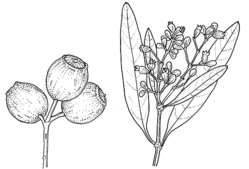Common name: Northern Sandalwood
Santalum lanceolatum R.Br. APNI* Synonyms: Santalum megacarpum Gand. APNI*
Santalum leptocladum Gand. APNI*
Santalum lanceolatum var. angustifolium Benth. APNI*

Description: Erect shrub 3–7 m high, branches spreading and pendent.
Leaves ovate to narrow-elliptic, 2–9 cm long, 5–25 mm wide, apex acute to mucronate, surfaces concolorous or slightly discolorous, often slightly glaucous; petiole 2–10 mm long.
Flowers in terminal or axillary panicles or racemes, in upper axils, rarely exceeding the leaves; peduncle 5–30 mm long, pedicels 1 mm long. Receptacle 2–3 mm long. Tepals triangular, 3–5 mm long, greenish. Disc with knob-likes lobes. Ovary not fully inferior; stigma 4-lobed.
Drupe ovoid, 7–15 mm long, dark blue or purple, often galled, edible and sweet, with prominent apical scar.
Flowering: throughout year but mainly Aug–December
Distribution and occurrence: Grows in a wide range of woodland communities, from sandy sites to rocky hillsides; widespread but scattered, west from the upper Hunter Valley.
NSW subdivisions: NC, NWS, CWS, NWP, SWP, NFWP, SFWP
Other Australian states: Qld Vic. W.A. S.A. N.T.
Text by B. Wiecek
Taxon concept: Flora of NSW 3 (1992)
APNI* Provides a link to the Australian Plant Name Index (hosted by the Australian National Botanic Gardens) for comprehensive bibliographic data
***The AVH map option provides a detailed interactive Australia wide distribution map drawn from collections held by all major Australian herbaria participating in the Australian Virtual Herbarium project.
|


